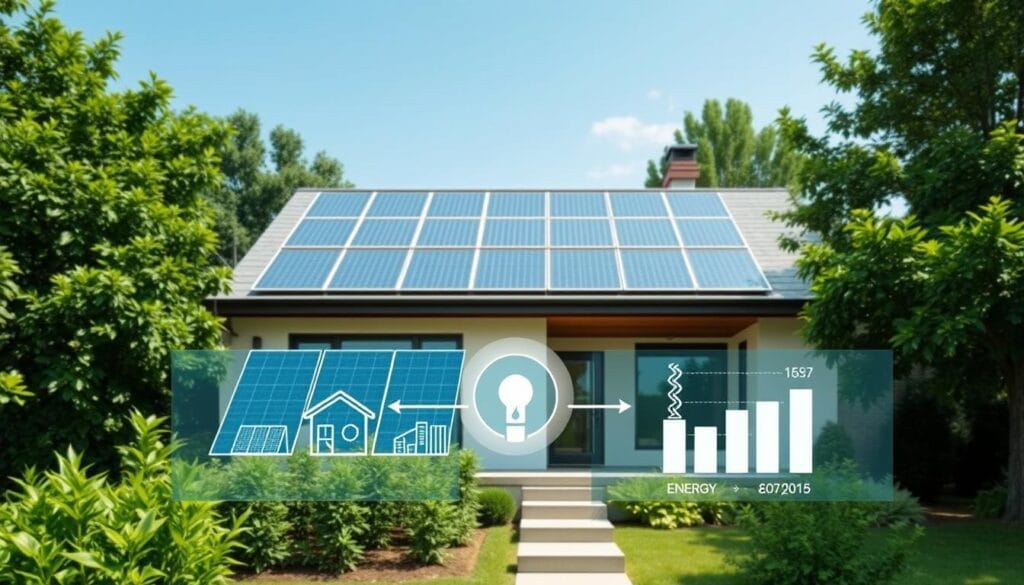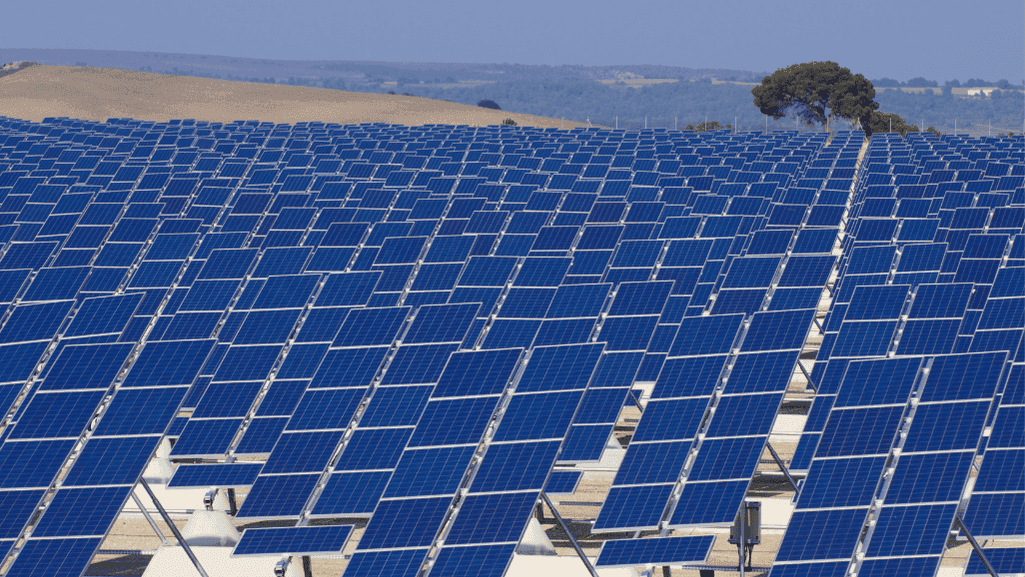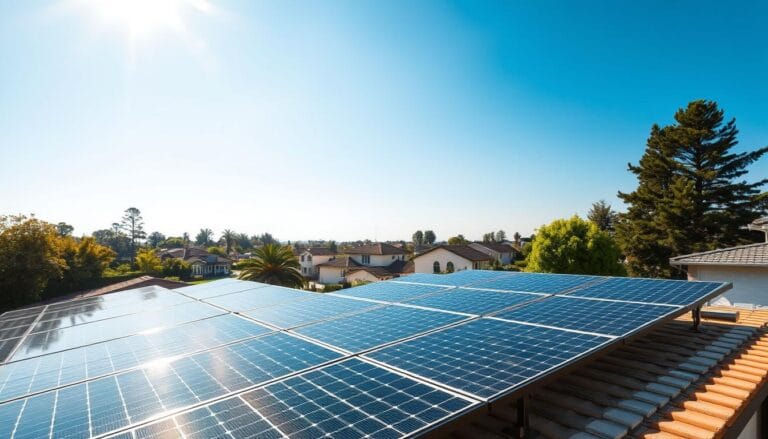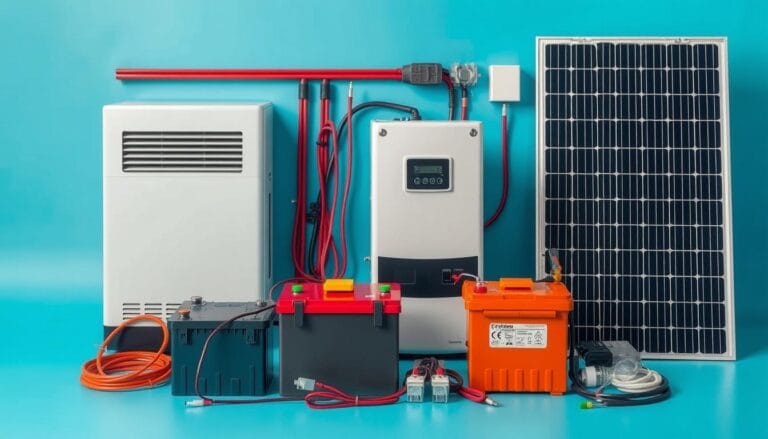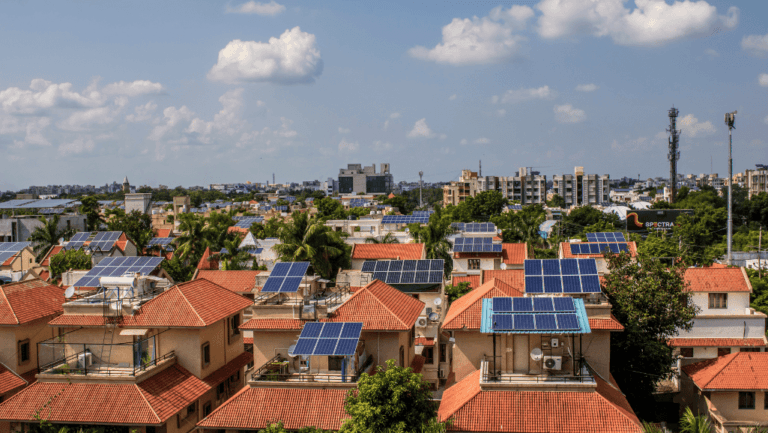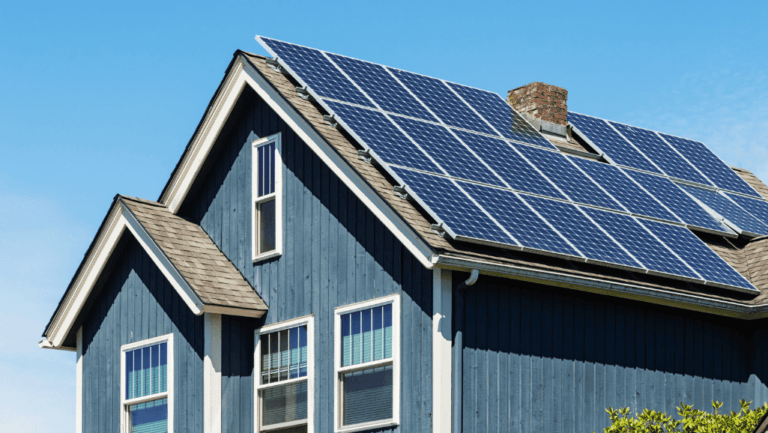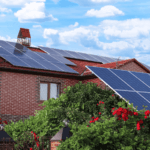Start using the sun’s power with solar panel kits for home. These systems are good for the planet and your wallet. You can choose from off-grid, grid-tied, or hybrid kits to meet your needs and location.
Getting a solar kit means less dependence on the grid and lower bills. These kits have everything you need, like panels, inverters, and cables. They help you use less energy and reduce your carbon footprint.
If you want to power a cabin or lower your environmental impact, eco-friendly home solar kits are a smart choice. Solar tech has improved, making these kits easier to use. Start your journey to energy freedom with solar panel kits today.
Key Takeaways
- Solar panel kits provide a cost-effective and eco-friendly way to power your home
- Customize your kit with off-grid, grid-tied, or hybrid solutions to fit your energy needs
- Reduce reliance on the grid and save money on electricity bills
- Kits come equipped with essential components like solar panels, inverters, and mounting hardware
- Embrace renewable energy and contribute to a greener future with home solar power kits
Advantages of Home Solar Panel Kits
Homeowners can save money and help the planet by using solar power. Solar panel kits are easy to install and let you make your own electricity. This is a great way to start using renewable energy.
Using solar panels can cut your energy bills a lot. You make your own electricity, so you use less from the grid. A June 2023 report by Wood Mackenzie says DIY solar can save up to 50% compared to hiring a pro.
Having solar panels also means you’re not tied to the grid. You get power even when the grid goes down. This is great for places with a lot of power outages or for those who want to use less fossil fuel.
Choosing solar panels is also good for the planet. You use the sun’s energy, which means less pollution. Every bit of clean energy you make helps fight climate change and keeps our planet healthy for the future.
“The sun is a daily reminder that we too can rise again from the darkness, that we too can shine our own light.” – S. Ajna
Solar panels are getting better and cheaper, making them popular. You can start small and add more panels later. This lets you meet your energy needs and budget as you go.
Starting your own solar project is rewarding. You save money, help the environment, and learn about renewable energy. With the right kit and knowledge, you can make your home a symbol of sustainability and inspire others.
Choosing the Right Solar Panel Kit for Your Home
Choosing the right solar panel kit for your home is key. You need to think about your energy needs, budget, and location. Whether you want to be off the grid or just cut down on bills, there’s a kit for you.
Off-Grid Solar Panel Kits
Off-grid kits are perfect for those who want to be completely independent. They come with batteries to store extra energy. This means you have power even when it’s not sunny. They’re great for cabins, tiny homes, or places far from the grid.
Grid-Tied Solar Panel Kits
Grid-tied kits help you save on energy bills while staying connected to the grid. They let you use your own clean power first. Any extra power can be sold back to the grid, giving you credits. These kits are perfect for those who want to use solar energy but still use the grid.
Hybrid Solar Panel Kits
Hybrid kits offer the best of both worlds. They give you a backup power source and let you use net metering when connected to the grid. They ensure you always have power, no matter what. With a hybrid kit, you get energy independence and grid convenience.
| Solar Panel Kit Type | Energy Independence | Grid Connection | Battery Storage |
|---|---|---|---|
| Off-Grid | Complete | No | Yes |
| Grid-Tied | Partial | Yes | No |
| Hybrid | Partial to Complete | Yes | Yes |
Choosing any solar panel kit is a big step towards a greener, more efficient home. It’s not just good for the planet; it also saves you money. By using solar power, you’re making a smart choice for your home and wallet.
Essential Components of a Solar Panel Kit
Starting your journey to power your home with clean energy is exciting. You’ll need to know about the key parts of a solar panel kit. These parts work together to turn sunlight into electricity for your home.
Solar Panels
Solar panels are at the heart of any solar system. They catch the sun’s rays and turn them into electricity. Most homes use mono cells, which are about 75% of the market.
Standard sizes are 60-cell/120-cell and 72-cell/144-cell. Larger panels are taller and heavier. When picking panels, look at cost per watt, efficiency, and warranty.
Inverters
Inverters are key after solar panels make DC electricity. They change this to AC, which homes use. Inverters make it possible for your appliances to work.
String inverters are cheaper when the sun shines fully. Microinverters, like Enphase’s IQ7, offer more flexibility. PV optimizers help with shading issues. Think about your needs and if you want a storage-ready inverter.
Mounting Hardware
Mounting hardware keeps solar panels in place and ready for the weather. Racking systems, like roof or ground mounts, are essential. Roof mounts are common for homes.
When choosing, consider your roof, panel size, and local weather. This ensures a safe and lasting setup.
Cables and Connectors
Cables and connectors wire your system together. They safely carry electricity to your home. You’ll need MC4 connectors and other outdoor-rated parts.
Make sure they can handle your system’s load. Proper installation is key for safety and efficiency.
| Component | Key Considerations |
|---|---|
| Solar Panels | Mono cells (75% of market), standardized sizes (60-cell/120-cell, 72-cell/144-cell), cost per watt, efficiency, warranty periods |
| Inverters | String inverters (cost-effective), microinverters (flexibility, modularity), PV optimizers (shading mitigation), storage-ready inverters |
| Mounting Hardware | Roof mounts (standard for homes), racking systems, compatibility with roof type and panel size, local climate considerations |
| Cables and Connectors | MC4 connectors (industry standard), outdoor-rated, UV-resistant, proper sizing for electrical load, safe installation |
Knowing about solar panel kit components helps you choose the right parts for your home. A well-designed kit means clean, sustainable energy for your home for years.
Calculating Your Home’s Energy Needs
Before you get into home solar energy, you need to know how much energy your home uses. Getting the right size for your solar panels is key. This ensures your system meets your energy needs and saves you money. Think about your daily energy use, appliances, and your home’s size and location.
Look at your past utility bills to figure out your monthly energy use. The average U.S. home uses about 900 kWh a month. But, this number can change a lot based on where you live and how big your home is.
The average American household uses 10,791 kWh of electricity per year, translating to an ideal system size of 7.2 kW or a solar array between 17 and 30 panels.
To find out how many solar panels you need, consider a few things:
- Annual energy consumption
- Panel wattage (usually 300 to over 400 watts)
- Production ratio (varies by location)
For example, a typical U.S. home in a sunny area needs a 6,000-watt system. Solar panels usually make about 250 watts each. But, SunPower panels can make up to 370 watts each. A home in Dallas, Texas, might need 25 regular panels or 17 SunPower panels.
| System Size (kW) | Estimated Number of Panels (400W) | Estimated Annual Production (kWh) |
|---|---|---|
| 4 | 10 | 6,000 |
| 6 | 15 | 9,000 |
| 8 | 20 | 12,000 |
| 10 | 25 | 15,000 |
| 12 | 30 | 18,000 |
| 14 | 35 | 21,000 |
Many solar panel kit providers have online tools or can give you advice. They help you find the right size and setup for your system. This way, your solar panels will give you enough energy, saving you money and the environment.
DIY Installation vs. Professional Installation
When it comes to installing your solar panel kit, you have two main options: do-it-yourself (DIY) installation or hiring a professional. Each approach has its advantages and considerations, and the choice ultimately depends on your skills, time, and project scope.
Recent surveys show that less than 0.3% of homeowners choose DIY solar panel installations. This highlights the rarity of this approach. However, for those willing to take on the challenge, DIY solar panel kits can offer significant cost savings. Customers can save around $5,000 compared to hiring professional solar panel kit suppliers.
Advantages of DIY Installation
DIY solar panel installations offer several benefits for the handy homeowner:
- Cost savings: By eliminating labor, overhead, and other professional installation expenses, you can reduce the overall cost of your solar panel system.
- Customization: DIY kits allow you to tailor your system to your specific needs and preferences.
- Learning opportunity: Installing your own solar panels can be a rewarding and educational experience, providing insight into the technology and its workings.
When considering a DIY installation, it’s essential to assess your technical skills and comfort level with electrical work. Many solar panel installation kits come with detailed instructions and customer support to guide you through the process.
When to Consider Professional Installation
While DIY solar panel installations can be tempting, there are situations where professional installation is the better choice:
- Lack of technical expertise: If you are unsure about your ability to handle the installation safely and correctly, it’s best to leave it to the professionals.
- Complex projects: For larger or more intricate solar panel systems, professional installers have the knowledge and experience to ensure optimal performance and reliability.
- Permitting and regulations: Professional installers are well-versed in local codes, permitting requirements, and utility company regulations, ensuring your system complies with all necessary standards.
Professional installation costs can range from $7 to $9 per watt, totaling $35,000 to $45,000 for a 5 kW system. While this is higher than DIY costs, professional installers often offer higher quality materials, warranties, and systems that can last for decades.
| Installation Type | Cost per Watt | Total Cost (5 kW System) |
|---|---|---|
| DIY Installation | $3 | $15,000 |
| Professional Installation | $7 – $9 | $35,000 – $45,000 |
Ultimately, the decision between DIY and professional installation depends on your unique situation. For off-grid solutions like powering sheds or RVs, DIY installation may be more applicable. However, for grid-connected homes, professional installation is often recommended to ensure proper installation, permitting, and compliance with utility company requirements.
Top Solar Panel Kit Brands for Home Use
Choosing the right brand for solar energy at home is key. With many options, picking one can be tough. We’ve listed the top brands known for quality, reliability, and making customers happy.
Renogy is a favorite, offering kits for all home sizes and energy needs. Their kits are easy to install and come with great warranties. Grape Solar is also popular for its quality and good prices.
WindyNation is known for its durable and high-performing kits. They include everything you need, like panels and inverters. Go Power is great for off-grid living or backup systems.
“I did extensive research on solar panel kit reviews before making my purchase, and I’m so glad I went with Renogy. The quality is outstanding, and their customer support is top-notch.” – Sarah, homeowner
When looking at prices, think about long-term savings. Some brands might cost more upfront but offer better value in the long run. Here’s a table comparing some popular brands:
| Brand | Kit Size | Price Range | Warranty |
|---|---|---|---|
| Renogy | 100W – 400W | $200 – $1,200 | 25 years |
| Grape Solar | 100W – 540W | $150 – $1,500 | 25 years |
| WindyNation | 100W – 400W | $250 – $1,000 | 25 years |
| Go Power | 130W – 480W | $400 – $1,800 | 25 years |
The best brand for you depends on your energy needs, budget, and what you like. Read reviews, compare features, and think about warranty and support. Choosing a reputable brand means clean energy for years, saving money and the planet.
Maximizing Energy Efficiency with Solar Panel Kits
Choosing renewable energy home kits is a wise move for those wanting to cut down on energy costs and help the planet. To get the most out of your solar panel kit, think about adding more energy-saving steps. These should match your green upgrades.
Proper Solar Panel Orientation
Getting your solar panels to face the right direction is key. In the northern hemisphere, aim them south and adjust the tilt for your location. This boosts how much energy they make. For instance, a 5kW DIY kit can produce 350 to 850 kWh monthly with 13 panels, if set up right.
Energy-Efficient Appliances
Using the sun’s power is just the start. Also, pick appliances that use less energy. Look for the Energy Star label, which shows they’re energy-smart. Using these with your solar kit can save even more energy and cut down on grid use.
| Solar Panel Kit | Starting Price | Monthly Generation (kWh) | Number of Panels |
|---|---|---|---|
| 3kW DIY Solar Panel Kit with Microinverters | $6,180 | 225 to 500 | 8 |
| 4kW DIY Solar Panel Kit with Microinverters | $7,778 | 300 to 750 | 10 |
| 7kW DIY Solar Panel Kit with String Inverters | $11,172 | 450 to 1200 | 18 |
| 8kW DIY Solar Panel Kit with String Inverters | $12,703 | 500 to 1400 | 20 |
Home Insulation and Weatherization
Good insulation and weatherproofing keep your home cozy and save energy. High-quality insulation and sealed air leaks help your heating and cooling systems work less hard. This lets your solar kit power more of your home.
“Combining energy efficiency measures with solar panel kits is the key to unlocking the full potential of renewable energy for your home. By taking a holistic approach, you can significantly reduce your carbon footprint and achieve long-term energy savings.” – Sarah Thompson, Green Energy Expert
As tech gets better, solar panels get more efficient. Companies like Fenice Energy now offer kits with cells up to 25% efficient. High-efficiency panels and smart energy-saving steps make homes sustainable and cost-effective.
Incentives and Rebates for Home Solar Panel Kits
Getting solar energy for your home is easier now, thanks to solar panel kit incentives. You can get federal tax credits and state and local rebates. These can cut down the cost of solar panels, making them a great choice for saving money and the planet.
Federal Tax Credits
The Solar Investment Tax Credit (Solar ITC) is a big help for homeowners. It gives a 30% credit on solar costs, lowering your taxes. For example, a $10,000 solar kit could mean a $3,000 tax credit.
But, the credit will drop to 26% in 2033 and to 22% in 2034. It will end in 2035 unless Congress acts. So, it’s key to use this tax credit now to save the most.
State and Local Incentives
Many states and local areas also offer solar rebates and incentives. These can vary by where you live. Some common ones include:
- Cash rebates for the size of your solar kit
- Payments for the electricity your system makes
- Property tax breaks for solar value
- Low-interest loans or grants for solar installation
Let’s look at Oregon’s incentives:
| Utility Company | Solar Incentive | Battery Storage Incentive |
|---|---|---|
| Portland General Electric | $1,000 per home | $500/kWh, max $6,000 per home |
| Pacific Power | $1,200 per home | $500/kWh, max $6,000 per home |
Oregon’s Solar Within Reach program also offers more help for low-income homes. This makes solar more affordable for more people.
By combining federal, state, and local incentives, you can cut the cost of your solar kit. You’ll get a quicker return on your investment.
If you finance your solar kit, you might not get these incentives. They’re for the system owner. To get the most benefits, talk to a tax expert and local officials. They can help you understand what’s available in your area.
Maintenance and Upkeep of Home Solar Panel Kits
While solar panel kits are built to last and need little care, regular maintenance is key. It keeps your home solar system working well and lasting longer. Keeping your solar panel kit in good shape helps you get the most out of clean, green energy.
Cleaning your solar panels is a big part of keeping them running right. Dust, dirt, and snow can cut down on how much energy they make. Clean them often with a soft brush or a special cleaner suggested by the maker.
It’s also important to watch how your solar panel kit is doing. Most kits have software or apps to track energy use and spot problems. This lets you fix issues fast and keep your system running smoothly.
If your kit has a battery for backup, following the maker’s care tips is crucial. Taking good care of your battery helps it last longer. This means you’ll have power when the grid goes down or when it’s dark.
Preventive maintenance for your solar panel kit boosts energy output and extends its life. This saves you money over time.
For your solar kit to last and work well, get it checked by a pro now and then. These checks can find problems like loose wires or damaged parts that you might miss.
| Solar Panel Kit Maintenance Task | Recommended Frequency |
|---|---|
| Cleaning solar panels | Every 6-12 months, or as needed |
| Monitoring system performance | Weekly or monthly |
| Battery maintenance (if applicable) | As per manufacturer’s guidelines |
| Professional inspection | Every 1-2 years |
By being proactive with solar panel kit care, you can:
- Boost energy output and efficiency
- Make your solar system last longer
- Find and fix problems early
- Keep your investment in green energy safe
Remember, a well-kept solar panel kit gives you reliable, efficient energy. It also helps make our world greener and more sustainable.
Environmental Impact of Home Solar Panel Kits
Getting a home solar panel kit is a great way to cut down on your environmental impact. It lets you use clean, renewable energy from the sun. This means you use less fossil fuels and make less pollution than traditional electricity.
Using a solar panel kit for years can really help the planet. These kits not only lower your carbon footprint but also help future generations. By supporting solar energy, you help make it better and more affordable for everyone.
The good things about solar panels go beyond just cutting down on pollution. Most panels are made from glass and metals that can be recycled. This recycling process, called delamination, helps get the most out of these materials and ensures they’re disposed of safely.
By choosing eco-friendly home solar kits, you become an active participant in the global effort to combat climate change and preserve our planet for future generations.
It’s key to think about the environmental impact of different solar panels:
- Monocrystalline panels have the highest carbon footprint during manufacturing due to the complex silicon moulding and cutting process.
- Polycrystalline panels, although involving high electricity consumption during production, are less environmentally damaging compared to monocrystalline panels.
- Thin-film solar panels leave a smaller carbon footprint but are created from highly toxic materials that can lead to significant human and environmental damage if not properly disposed of.
Solar batteries are also important to consider for their environmental impact. If not disposed of safely, they can release harmful fumes. This shows how crucial it is to handle them responsibly when they’re no longer needed.
| Solar Panel Type | Environmental Impact |
|---|---|
| Monocrystalline | Highest carbon footprint during manufacturing |
| Polycrystalline | Less environmentally damaging than monocrystalline |
| Thin-film | Smallest carbon footprint but made from toxic materials |
Choosing the right components for your solar panel kit and taking care of it can make a big difference. Using eco-friendly solar kits not only helps you but also contributes to a greener future. It’s all about using clean, renewable energy to make our planet better for everyone.
Solar Panel Kits and Home Value
Getting a solar panel kit for your home saves a lot on energy and can raise your home’s value. More people want homes that use renewable energy. So, installing solar panels makes your home more appealing to buyers and can get you a better price when you sell.
Research shows homes with solar systems sell quicker and for more money than similar homes without. A study by the National Renewable Energy Laboratory found homes with solar panels sell for 4.1% more. This means you could get back some of what you spent on solar panels by selling your home for more.
Thinking about the long-term benefits of solar is key. It’s not just about saving money on energy. It’s also about making your home more valuable when you sell. Choosing a good solar panel kit from a trusted company like Unbound Solar ensures your home will attract buyers.
Unbound Solar has many solar panel kits for different homes and energy needs. Their kits include everything you need, like panels, inverters, and cables. This makes it easier for homeowners to install the system themselves.
| Solar Panel Kit | Price | Battery Capacity | Recharge Time |
|---|---|---|---|
| P-100+55W Solar Panel Kit | ₦509,597.00 | 102Wh (12.8VDC, 8Ah) | ≈3.2-3.7 hrs |
Choosing the right solar panel kit is important. Consider your energy use, roof space, and local weather. A company like Unbound Solar can help you pick the best system for your home.
Adding solar panels to your home is a smart and safe investment. Remodeling Magazine’s 2019 Cost VS Value Report says solar panels give the highest return on investment, even more than a new kitchen!
Installing solar panels shows you care about the environment and reduces your home’s carbon footprint. As more people look for eco-friendly homes, a solar-powered home stands out. It attracts buyers who are willing to pay more for green living.
Getting a solar panel kit offers immediate savings on energy and makes your home more valuable over time. As more people want sustainable homes, a solar-equipped property is a wise choice. It appeals to buyers and can increase your home’s value.
Conclusion
Investing in solar panel kits is a great way for homeowners to use affordable solar power. It helps cut down on bills and supports a greener planet. There are many types of kits, like off-grid and grid-tied, to fit your needs and budget.
To get the most out of solar panel kits, know your energy needs well. Choose a trusted brand and think about installation, upkeep, and energy saving. Using incentives and rebates can make your solar investment even more affordable. This move not only makes your home energy-independent but also helps the planet for future generations.
Choosing solar panel kits means you’re part of a growing group of eco-friendly homeowners. You’ll save money, increase your home’s value, and reduce carbon emissions. With technology improving, solar kits are getting better and cheaper. Start your journey to a greener future by looking into solar panel kits for your home.



